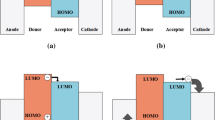Abstract
Polymer solar cells are considered as very promising candidates for the development of photovoltaics of the future. They are cheap and easy to fabricate, however, up to now, they possess a fundamental drawback: low effectiveness. One ask the question how fundamental this limitation is. We propose the simple model which examines the limitations of efficiency by analysis of geometrical aspects of the bulk heterojunction (BHJ) architecture. We calculate the effective area of the donor-acceptor border in the random mixture of the donor and the acceptor nanocrystals and further compare it with an ideal “brush architecture”. It turns out that in the BHJ architecture, this effective areas are very close to the value obtained in the “brush” one. Implications of this fact are discussed: we consider some other factors, which could limit the efficiency of the BHJ architecture, try to estimate its scale and speculate on possibilities of realization of another architectures and materials in the construction of solar cells.
Access this chapter
Tax calculation will be finalised at checkout
Purchases are for personal use only
Similar content being viewed by others
References
http://commons.wikimedia.org/wiki/File:PVeff(rev181217)v2.pdf. Accessed 4 Oct 2019
Heeger, A.J.: Semiconducting and metallic polymers: the fourth generation of polymeric materials (Nobel lecture). Angew. Chem. Int. Ed. 40, 2591–2611 (2001)
Janssen, R.A.J., Nelson, J.: Factors limiting device efficiency in organic photovoltaics. Adv. Mater. 25, 1847–1858 (2013)
Rand, B.P., Richter, H. (eds.): Organic Solar Cells: Fundamentals, Devices, and Upscaling, 1st edn. CRC Press, Taylor & Francis Group, Boca Raton (2014)
Yu, G., Heeger, A.J.: Charge separation and photovoltaic conversion in polymer composites with internal donor/acceptor heterojunctions. J. Appl. Phys. 78, 4510–4515 (1995)
Halls, J.J.M., et al.: Efficient photodiodes from interpenetrating polymer networks. Nature 376(6540), 498–500 (1995). https://doi.org/10.1038/376498a0
Yu, G., Gao, J., Hummelen, J.C., Wudl, F., Heeger, A.J.: Polymer photovoltaic cells: enhanced efficiencies via a network of internal donor-acceptor heterojunctions. Science 270, 1789–1791 (1995)
Yang, C.Y., Heeger, A.J.: Morphology of composites of semiconducting polymers mixed with C60. Synth. Met. 83, 85–88 (1996)
Gunes, S., Neugebauer, H., Sariciftci, N.S.: Conjugated polymer-based organic solar cells. Chem. Rev. 107, 1324–1338 (2007)
Stauffer, D., Aharony, A.: Introduction to Percolation Theory. CRC Press, Taylor & Francis Group, Boca Raton (1994)
Lunt, R.R., Holmes, R.J.: Small molecule and vapor-deposited organic photovoltaics. In: Rand, B.P., Richter, H. (eds.) Organic Solar Cells: Fundamentals, Devices, and Upscaling, 1st edn. CRC Press, Taylor & Francis Group, Boca Raton (2014)
Zhang, Q., et al.: Small-molecule solar cells with efficiency over 9%. Nat. Photonics 9, 35–41 (2015)
Chen, W., et al.: Nanophase separation in organic solar cells. In: Qiao, Q. (ed.) Organic Solar Cells: Materials, Devices, Interfaces and Modeling. CRC Press, Taylor & Francis Group, Boca Raton (2015)
Wojtkiewicz, J., Pilch, M.: Modelling of limitations of bulk heterojunction architecture in organic solar cells. ArXiv:1709.01048
Shockley, W., Queisser, H.J.: Detailed balance limit of efficiency of p-n junction solar cells. J. Appl. Phys. 32, 510–519 (1961)
Author information
Authors and Affiliations
Corresponding author
Editor information
Editors and Affiliations
Rights and permissions
Copyright information
© 2020 Springer Nature Switzerland AG
About this paper
Cite this paper
Wojtkiewicz, J., Pilch, M. (2020). Modelling of Limitations of BHJ Architecture in Organic Solar Cells. In: Wyrzykowski, R., Deelman, E., Dongarra, J., Karczewski, K. (eds) Parallel Processing and Applied Mathematics. PPAM 2019. Lecture Notes in Computer Science(), vol 12044. Springer, Cham. https://doi.org/10.1007/978-3-030-43222-5_28
Download citation
DOI: https://doi.org/10.1007/978-3-030-43222-5_28
Published:
Publisher Name: Springer, Cham
Print ISBN: 978-3-030-43221-8
Online ISBN: 978-3-030-43222-5
eBook Packages: Computer ScienceComputer Science (R0)




